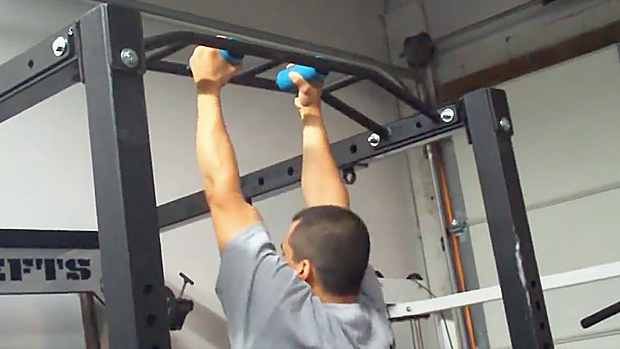Lately there's been much discussion about whether it's more beneficial to do total body training (TBT) or some version of a split system where parts of the body are separated for different workouts.
There are diehard followers in each camp, and usually the discussion breaks down into two people yelling at each other as if they're talking about politics or religion. Sometimes, to avoid serious debate, people focus on what they have in common instead of the important differences of each system. My goal is to avoid both of those situations and detail the benefits and drawbacks of both methods of training so that you can decide which method is the most appropriate for you at the current time.
The Definitions
First, we need to define what we're talking about. I think most people know a total body program when they see it, but to be clear I define it as doing at least one of each of the following exercises in one workout session:
- Upper body pushing exercise (chest and/or shoulders)
- Upper body pulling exercise (lats)
- Compound exercise for the lower body (glutes, quads, and hamstrings)
A split program is defined as doing two or less of the previously listed exercises. Examples would include upper/lower, push/pull, or doing just one or two body parts per workout.

When discussing these two systems, it's imperative that we do everything possible to just analyze the systems themselves and not other variables. How can we do that? Simple, make everything else about the two programs the same.
The real question asked by debating TBT vs. splits is: what frequency is best for muscle stimulation? Frequency in this case refers to how often, usually per week, each muscle or movement is getting stimulated. The vast majority of people fall into one of three frequencies. Those who train each muscle group three times a week, those who train each muscle group twice a week, and those who train each muscle group once a week.
First, we should ask ourselves, is this a valid question? Does it really matter? I believe the answer is yes to both questions. This is a valid question because essentially all coaches and trainers agree that having the proper frequency is crucial to achieving success in the gym. It does matter because this question tries to address one of the key training paradigms: as a person's fitness level increases, he needs to do more work to further increase his fitness. The flipside of that paradigm is that the more work you do, the more recovery time you need. So I believe that any attempt to solve this puzzle is a worthwhile endeavor.
The Variables & The Workouts
So let's get down to it. What we're really talking about is frequency, so in order to judge only that, all the other variables must be the same. That means you do the same exercises over the course of the week, same sets, same reps, same weight, same rest time, same total workout time, and the same number of sessions per week. Everything is the same; the only thing that changes is the frequency.
I mentioned above that most people either train each body part once, twice, or three times per week. Training each group two times a week is kind of a compromise. The total body guys seem to agree that sometimes two times a week is good; the once a week guys agree that sometimes twice a week is good as well.
That is all fine and dandy, but we want to see the differences between these two plans, so let's get twice a week out of there. Don't get me wrong, I'm not saying that twice a week training is bad by any means, but the following discussion will focus on the pros and cons of training every muscle group three times a week or just once a week. Twice a week fits essentially in the middle of the two and tries to bridge the gap between them.
We said before that both workouts are the same except for the split. Since some people are visual learners, here's how the two workouts might look side by side. The set-up for the TBT workout was taken from how I understand Chad Waterbury's recommendation for his program that he calls (get ready for it) TBT. The exercises are listed in the order that they'd be performed. Generally this workout would be preformed on Monday, Wednesday, and Friday.
| Day 1 – TBT | Day 1 – Chest and Back |
|---|---|
| Bench Press | Bench Press |
| Pull-ups | Dumbbell Incline Press |
| Military Press | 3-Board Press |
| Front Squats | Pull-ups |
| Tricep Pushdowns | Bent Over Row |
| Dumbbell Bicep Curl | Dumbbell Row |
| Day 2 – TBT | Day 2 – Legs and Lower Back |
| Dumbbell Incline Press | Squats |
| Bent Over Row | Front Squats |
| Push Press | Deadlifts |
| Squats | Good Mornings |
| Decline Skull Crushers | Seated Leg Curl |
| Seated Leg Curl | |
| Day 3 – TBT | Day 3 – Shoulders and Arms |
| Deadlifts | Push Press |
| Good Mornings | Military Press |
| 3-Board Press | Dumbbell Rear Delt Raise |
| Dumbbell Row | Decline Skull Crushers |
| EZ Curl | Tricep Pushdowns |
| Dumbbell Rear Delt Raise | EZ Curl |
| Dumbbell Bicep Curl |
As you look over the above workouts you may see something you particularly like or don't like. Let's say you hate leg curls and think people should do glute ham raises instead. Simply substitute in any exercise you want. To be balanced, you just have to substitute the same exercise in both routines.
In addition, if you feel like something is missing, say abs, feel free to add abs in there, just be aware that whatever you do to one routine, you do to the other routine. The purpose of outlining the workout like this is simply so people can see the differences and how they might appear in a practical sense.
So, now that we have the workout down, let's begin by analyzing it. First, the good stuff:
The Pros of Total Body Training
- More frequency may be better for increased neuromuscular coordination – this is one crucial component of strength, a big benefit. Practice makes perfect and generally you get a better practice effect by doing it shorter and more often then just one long session.
- You're relatively "fresh" for each exercise since you hit one area of the body and move on, so there's not much of an accumulated specific fatigue effect.
- It's easier to incorporate total body exercises like the Olympic lifts, gymnastics moves, and strongman stuff into this type of routine.
- Essentially all fitness professionals agree that total body is ideal for beginners.
- TBT may better prepare an athlete to handle total body fatigue (as in a game) than split training.
- As Waterbury has pointed out, TBT hits a higher percentage of the total motor units in the body per day than a split plan.
- Because you're working your whole body, TBT may be better at burning calories and promoting fat loss.
- TBT is good for recovery from an injury or a layoff because by default the intensity is reduced so you'll get more out of it practicing more often.
- If you miss a workout or two for the week, you still provided some training stimulus to your whole body instead of neglecting it for that week.
- Having a greater frequency can help prevent undertraining.
- It's easy to implement supersets (antagonistic sets) which save time.
- Easy total body days are harder than easy split days (i.e. total body vs. arms).
- You don't get the deep soreness from a TBT routine that you do from a split routine.
- You can get a good overall workout in only three days a week.
- Personal opinion – I've found that it seems easier to do a hard TBT session without a partner than a hard split program without a partner.
Pros of Split Training
- Split training allows for maximum intensity regardless of level of advancement.
- Repeated sets on a fatigued muscle will build muscular endurance better (particularly multiple set endurance).
- Split training allows you to workout more than three days a week easily.
- Extra training days allow more time to devote to weak points in physique or performance.
- Split training gives muscles more time to recover which can help prevent overtraining.
- Essentially all fitness professionals agree that split training is better for bodybuilders and fitness athletes.
- Split training hits a higher percentage of the total motor units in the body per week than a TBT plan. As a muscle is fatigued you recruit more motor units, which is better for hypertrophy (muscle size).
- The hardest split day is usually harder than the hardest total body day (i.e. legs vs. total body).
- Easy to do intensity techniques (i.e. drop sets, compound sets, etc.)
- May do a better job of teaching someone to lift intensely.
- You tend to get very sore and feel the muscle you worked several days afterward (some people like this feeling, some don't).
- Split training is better if you have to train multiple days in a row (i.e. Tuesday, Wednesday, and Thursday are the only days you can lift).
Cons of Total Body Training
- High frequency combined with high intensity may overtrain certain areas of the body (ex. shoulders from pressing three days a week, tendonitis in elbows, etc.).
- Most split programs allow a person to workout 4-5 plus times a week. It's difficult to do more than three days a week on a TBT plan because then you start training on back to back days.
- TBT may not allow enough recovery time, particularly if you work at a high (relative) intensity or if you lift a lot of weight (high absolute intensity).
- May not allow enough work to improve or correct weak points. Or if weak points are addressed along with regular training, that may lead to overtraining.
- Lifters may be tempted to decrease intensity because they're doing basically the same thing again in a few days.
- May not build up local muscular endurance or resistance to fatigue (lactate threshold) as much as a split plan.
- It's difficult to implement most intensity techniques (i.e. drop sets, compound sets) due to short recovery time (in days) before the muscle is stimulated again.
- You don't get much of a pump in a specific muscle group, which some people like (and Arnold says it's the greatest feeling you can get).

Cons of Split Training
- Lack of frequency may not increase neuromuscular coordination as much, which may limit strength.
- You're somewhat fatigued after your first exercise for a certain body part, so continuing to train that area forces a slight reduction in weight.
- Splits must be planned out properly to prevent overtraining of susceptible body parts or areas (i.e. lower back, front delts, etc.).
- Hard to fit in and place total body exercises or combination exercises (thrusters, Olympic lifts, etc.).
- Splits may not promote total body fatigue and thus the lifter may not be prepared for that.
- Lifter may not be stimulating the muscle intensely enough to require such a long recovery time (in days).
- You may feel the need to train 4-5 times per week and thus it takes up more time.
- Opinion – You may need a workout partner to regularly have really good split workouts.
Anecdotal Evidence
Looking at past and current athletes, both systems have anecdotal evidence in their favor. That evidence is:
- Total body training has been used successfully in the past to build big and strong athletes.
- Olympic lifters, gymnasts, some athletes, and some strength coaches continue to use total body training with good results.
- Essentially all bodybuilders and fitness athletes use a split system.
- Most regular people who lift weights in the gym (average person in Gold's Gym) use a split system.
- Split training seems to be (at least in my experience) more fun for most people and that isn't to be discounted. The number one reason why people continue to do something longer term is because it's fun.
The Poor Arguments
In addition, during this debate both sides have made some claims that don't really have much merit and which should be debunked. Some of those claims are:
Poor Argument #1: "Muscles always work together in real life and you can't separate muscles in the gym."
The body is an amazing unit and we have yet to fully understand it; however, the idea that not always doing a full body routine will lead to less functional muscles makes no sense.
Look again at the workouts described above. To say that the total body person will get a better effect for sprinting because they trained their lats and glutes together – as opposed to the split person who trained lats and glutes on separate days – makes no sense.
If I develop strong biceps in the gym, even if I just had a single day for biceps, those strong biceps will help me in whatever activities I do that involve the biceps, be it rope climbing or tug-of-war or arm wrestling. The frequency component of the routine has very little to do with how well abilities in the gym transfer over to other abilities outside of the gym.
Poor Argument #2: "Many muscles are working in an exercise (like an oblique in a lateral raise, abs in a military press, calves in a squat), so how can you separate out what muscles an exercise really works?"
This is basically saying that doing something like a chest day or a back day makes no sense. I'm not sure where this claim came from, as it seems like this question was addressed and solved years ago and now it's popping up again.
True, many muscles work in an exercise, and muscles rarely work in pure isolation. However, the problem is the definition of "work." Many muscles do contract during an exercise, but that's much different from muscles receiving a training stimulus from an exercise. A training stimulus means the muscles will respond from the exercise by getting bigger, stronger, increased endurance, etc.
Here's an easy way to think about it. When you're doing an exercise, ask yourself, "If I just do this one single exercise and that's it, what muscles will respond to that?" For example, are the biceps working in a bench press? If by "working" you mean contracting, then yes, absolutely, the biceps contract during a bench press. Rip your biceps and then bench the next day and you'll realize that they do contract.
However, will doing only the bench press give you bigger and stronger biceps? No, it won't. The biceps don't receive much training stimulus from the bench. The triceps certainly do and the delts do, but not the biceps. If all you do is bench and then you expect to have a very good biceps curl (a measure of biceps strength) you're going to be very disappointed.
Going back to our original examples, the idea that doing lateral raises will improve your obliques so that you're better at side crunches or rotations doesn't hold water, just like doing military presses isn't going to make you much better at crunches and squatting isn't going to give you great calves.
Poor Argument #3: "Total body training is too easy; only wimpy people use it."
This is simply not correct. It's load, exercises, sets, reps, and rest that make a workout easy or hard. Look at the workout above: deadlifts followed by good mornings and then board press and dumbbell rows – all of those are tough movements. Doing them all in a row with heavy weight would be brutal.
Ask any powerlifter if a powerlifting meet (a total body workout) is easy and obviously they'll say no. You can make a total body workout easy just like you can make a split easy, but is it automatically easy? Definitely not.
Poor Argument #4: "Total body training may be good for beginners, but that's about it."
Again this doesn't have to be the case. Look at elite Olympic lifters; they're stressing the whole body all the time and have great performance. Sheiko oriented powerlifting programs have lifters training with a very high frequency on a regular basis. While it's true that you have to balance out the intensity of the workout with the frequency of the workout, there are enough examples to prove that TBT can work with advanced people.
Conclusion?
So what's the conclusion? Hopefully you can see that both methods do have significant benefits, and most people would benefit from spending time on both methods. A key point to remember is that the ideal frequency for you isn't static; it's dynamic because you're changing and by default your training intensity is changing.
In general, it's true that many people start out with total body training and then move on to twice a week for a while and then once a week for while, and this matches the increase of their training intensity. However, once a week isn't necessarily the pinnacle that everyone is striving for. Periodically, you should reassess where you are and where your training is to see if that's still a good place for you to be.
The Take Home Message
Total Body Guys – TBT can be very effective, as you know, but as you progress you may find your body would benefit by training hard with a more direct, intense stimulus on the muscle and then letting it have more time to recover, particularly if you're looking for muscular growth or if you're lifting very heavy weights.
You may also find that it'll allow you to focus on some weak points that you haven't been able to prioritize. You can always try a split routine (once or twice a week frequency) for a while and go back if you don't like it. You won't lose the gains you've made.
Split Guys – Split training can be very effective, as you know. However, as you reach very intense levels of training you may find that your ability to work yourself out now exceeds your ability to recover, even training each muscle group only once a week. As Lee Haney said, "Train to stimulate, not annihilate."
So you may find that you've been slightly decreasing the intensity over time, perhaps as you got bigger or stronger, or maybe your training partner moved away. Your body may now be ready to respond better to a higher frequency and a (slightly) lower intensity. You can always try a higher frequency (twice or three times a week) for a while and go back if you don't like it. Nope, you won't lose the gains you've made.
The Bottom Line
How will your body respond to training each muscle group or movement X number of times per week? If you don't know the answer to that question, that may be a signal that it's time to change things up.
You can always try doing one month of three times a week, one month of twice a week, and one month of once a week and find out. Think about it, try it, and see what happens!





